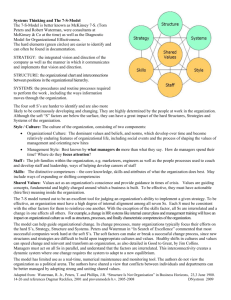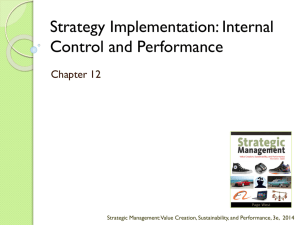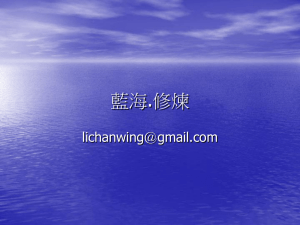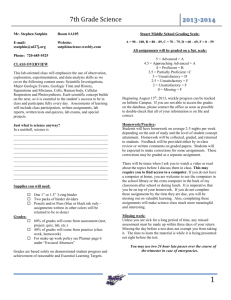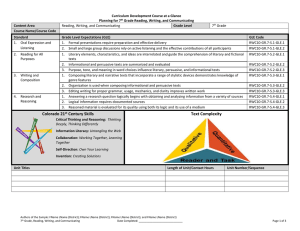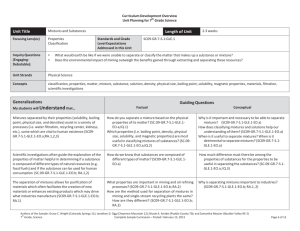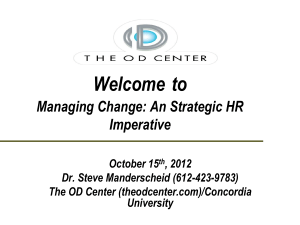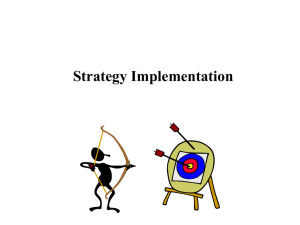Document 15590634
advertisement
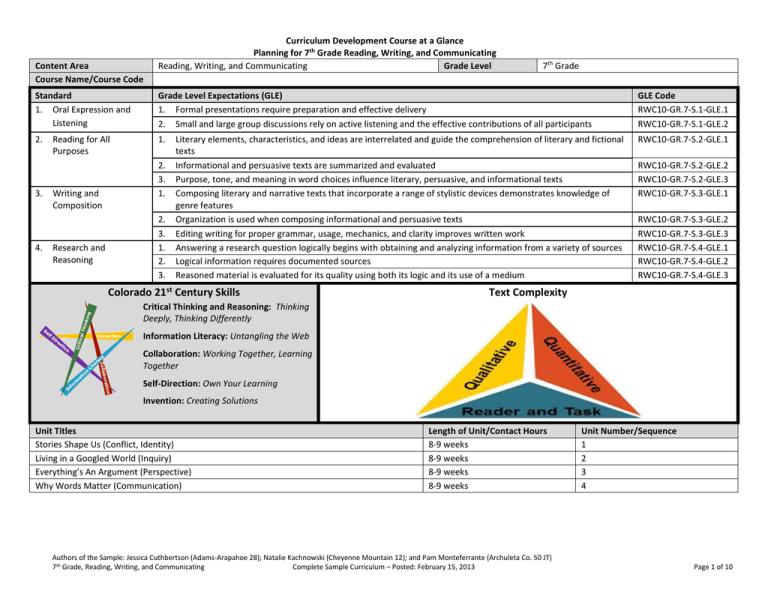
Content Area Course Name/Course Code Curriculum Development Course at a Glance Planning for 7th Grade Reading, Writing, and Communicating Reading, Writing, and Communicating Grade Level 7th Grade Standard 1. Oral Expression and Listening Grade Level Expectations (GLE) 1. Formal presentations require preparation and effective delivery 2. Small and large group discussions rely on active listening and the effective contributions of all participants GLE Code RWC10-GR.7-S.1-GLE.1 RWC10-GR.7-S.1-GLE.2 2. 1. RWC10-GR.7-S.2-GLE.1 3. 4. Reading for All Purposes 2. 3. 1. Writing and Composition 2. 3. 1. 2. 3. Research and Reasoning Literary elements, characteristics, and ideas are interrelated and guide the comprehension of literary and fictional texts Informational and persuasive texts are summarized and evaluated Purpose, tone, and meaning in word choices influence literary, persuasive, and informational texts Composing literary and narrative texts that incorporate a range of stylistic devices demonstrates knowledge of genre features Organization is used when composing informational and persuasive texts Editing writing for proper grammar, usage, mechanics, and clarity improves written work Answering a research question logically begins with obtaining and analyzing information from a variety of sources Logical information requires documented sources Reasoned material is evaluated for its quality using both its logic and its use of a medium Colorado 21st Century Skills RWC10-GR.7-S.2-GLE.2 RWC10-GR.7-S.2-GLE.3 RWC10-GR.7-S.3-GLE.1 RWC10-GR.7-S.3-GLE.2 RWC10-GR.7-S.3-GLE.3 RWC10-GR.7-S.4-GLE.1 RWC10-GR.7-S.4-GLE.2 RWC10-GR.7-S.4-GLE.3 Text Complexity Critical Thinking and Reasoning: Thinking Deeply, Thinking Differently Invention Information Literacy: Untangling the Web Collaboration: Working Together, Learning Together Self-Direction: Own Your Learning Invention: Creating Solutions Unit Titles Stories Shape Us (Conflict, Identity) Living in a Googled World (Inquiry) Everything’s An Argument (Perspective) Why Words Matter (Communication) Length of Unit/Contact Hours 8-9 weeks 8-9 weeks 8-9 weeks 8-9 weeks Authors of the Sample: Jessica Cuthbertson (Adams-Arapahoe 28); Natalie Kachnowski (Cheyenne Mountain 12); and Pam Monteferrante (Archuleta Co. 50 JT) 7th Grade, Reading, Writing, and Communicating Complete Sample Curriculum – Posted: February 15, 2013 Unit Number/Sequence 1 2 3 4 Page 1 of 10 Curriculum Development Overview Unit Planning for 7th Grade Reading, Writing, and Communicating Unit Title Stories Shape Us Focusing Lens(es) Conflict Identity Inquiry Questions (EngagingDebatable): Unit Strands Oral Expression and Listening, Reading for all Purposes, Writing and Composition, Research and Reasoning Concepts In content: In reading: In writing: Conflict (internal/external), Identity, Relationships, Connections, Beliefs, Choices, Perspective, Collaboration, Consequences Inferences, Mood/Tone, Theme, Summary, Evaluation, Analysis, Characters/Characterization Story elements (setting), Narrative/Poetic techniques, Organization/sequence, Point of view Editing Length of Unit Standards and Grade Level Expectations Addressed in this Unit 8-9 Weeks RWC10-GR.7-S.1-GLE.1 RWC10-GR.7-S.1-GLE.2 RWC10-GR.7-S.2-GLE.1 RWC10-GR.7-S.3-GLE.1 RWC10-GR.7-S.3-GLE.3 RWC10-GR.7-S.4-GLE.1 RWC10-GR.7-S.4-GLE.2 How do stories reflect cultural values and shape citizens? (RWC10-GR.7-S.2-GLE.1-IQ.1) and (S.2-GLE.1-IQ.1; S.2-GLE.1-IQ.2) How does understanding conflict impact our understanding of a story and ourselves? What makes some stories timeless? (RWC10-GR.7-S.2-GLE.1-N.1) Generalizations My students will Understand that… Guiding Questions Factual Conceptual A deep analysis of literary texts and the study of characterization, cultivates an understanding of personal/cultural identities and a range of interpretations. (RWC10-GR.7-S.2-GLE.1-IQ.1; IQ.3; RA.1) and (RWC10GR.7-S.3-GLE.1-IQ.4) Which characters are most memorable to you and what aspects of those characters do you remember? (RWC10-GR.7-S.2-GLE.1-IQ.3) How do authors develop characters? How does characterization help readers identify with characters? Why do certain characters resonate with the audience? Differences in beliefs and perspectives between characters generate conflict in stories which provides insight into real-world conflicts. (RWC10-GR.7-S.3-GLE.1RA.1; IQ.2) and (RWC10-GR.7-S.2-GLE 1-IQ.4; N.1) What contributed to the conflict in this text? What types of conflict exist in stories? How might the outcome have been different if the character had made a different decision? The comparing and contrasting of texts broadens a reader’s perspective and facilitates deeper connections to diverse media and points of view. (RWC10-GR.7-S.2GLE.1-EO c.i, ii; N.1) What similarities and/or differences can a reader find when examining (text) and (text)? Why is it important to consider a variety of texts when forming opinions? Story elements guide the writer’s craft by providing a range of techniques and style possibilities. (RWC10-GR.7S.3-GLE.1-IQ.1, 3, 5; RA.2; N.1, 2) What is the definition of ‘theme’? (RWC10-GR.7-S.2GLE.1-EO.a.ii) How do we determine a theme in a story? Why is theme important? Authors of the Sample: Jessica Cuthbertson (Adams-Arapahoe 28); Natalie Kachnowski (Cheyenne Mountain 12); and Pam Monteferrante (Archuleta Co. 50 JT) 7th Grade, Reading, Writing, and Communicating Complete Sample Curriculum – Posted: February 15, 2013 Page 2 of 10 Curriculum Development Overview Unit Planning for 7th Grade Reading, Writing, and Communicating Critical Content: Key Skills: My students will Know… My students will be able to (Do)… Story elements including character, conflict, point of view, plot, setting, etc. (RWC10-GR.7-S.2-GLE.1-EO.a.ii-iv) Narrative techniques and genre features (RWC10-GR.7-S.3-GLE.1-EO.a.iii) The writing process (RWC10-GR.7-S.3-GLE.1-EO.a.b) Difference sentence types (simple, compound, complex, and compound-complex) (RWC10-GR.7-S.3.GLE.3-EO.b.ii) Standard conventions for capitalization, spelling and punctuation (RWC10-GR.7S.3-GLE.1-EO.b) and (RWC10-GR.7-S.3-GLE.3) Expectations for effective discussions and active listening (RWC10-GR.7-S.1-GLE.2.EO.a; IQ.ALL; N.1, 2) Cite several pieces of textual evidence to support analysis of what the text says explicitly as well as inferences drawn from the text (RWC10-GR.7-S.2-GLE.1-EO.a.i) Determine a theme or central idea of a text and support using text-based evidence (RWC10-GR.7-S.2-GLE.1-EO.a.ii) Analyze how particular elements of a story interact (RWC10-GR.7-S.2-GLE.1EO.a.iii) Compare and contrast two or more texts for theme, style, plot, - etc. (RWC10GR.7-S.2-GLE.1-EO.c.i,ii) Compose a narrative using a range of literary techniques (RWC10-GR.7-S.3-GLE.1EO.a) Revise and edit a narrative (RWC10-GR.7-S.3-GLE.1-EO.b, RWC10-GR.7-S.3-GLE.3EO.a, b, c, e) Engage effectively in a range of collaborative discussions (RWC10-GR.7-S.1-GLE.2.EO.a) Critical Language: includes the Academic and Technical vocabulary, semantics, and discourse which are particular to and necessary for accessing a given discipline. EXAMPLE: A student in Language Arts can demonstrate the ability to apply and comprehend critical language through the following statement: “Mark Twain exposes the hypocrisy of slavery through the use of satire.” A student in ______________ can demonstrate the ability to apply and comprehend critical language through the following statement(s): In the story “Seventh Grade” by Gary Soto the reader can infer that the main character’s conflict is the result of his internal struggle to impress a classmate. Academic Vocabulary: Analysis, Evidence, Citing/citation, Summarize, Determine, Compare/contrast, Infer/inference, Collaboration, Identity, Resonate Technical Vocabulary: Characterization, Setting, Mood, Tone, Plot, Theme, Conflict (internal/external), Point of view, Narrative/literary Authors of the Sample: Jessica Cuthbertson (Adams-Arapahoe 28); Natalie Kachnowski (Cheyenne Mountain 12); and Pam Monteferrante (Archuleta Co. 50 JT) 7th Grade, Reading, Writing, and Communicating Complete Sample Curriculum – Posted: February 15, 2013 Page 3 of 10 Curriculum Development Overview Unit Planning for 7th Grade Reading, Writing, and Communicating Unit Title Living in a Googled World Focusing Lens(es) Inquiry Discovery Inquiry Questions (EngagingDebatable): Unit Strands Oral Expression and Listening, Reading for all Purposes, Writing and Composition, Research and Reasoning Concepts In content: In reading: In writing: Inquiry, Collaboration/cooperation, Problemsolving, Choice, Change, Balance, Connections, Discovery, Interaction, Complexity, Ethics, Cause/effect, Fact/opinion Analyze, Summarize, Evaluate/interpret, Clarify, Synthesize, Determining credibility, infer, question, make connections Structure/format, organization (including transitions), composing/editing/revision, word choice/ vocabulary Length of Unit Standards and Grade Level Expectations Addressed in this Unit 8-9 weeks RWC10-GR.7-S.1-GLE.2 RWC10-GR.7-S.2-GLE.2 RWC10-GR.7-S.2-GLE.3 RWC10-GR.7-S.3-GLE.2 RWC10-GR.7-S.3-GLE.3 RWC10-GR.7-S.4-GLE.1 RWC10-GR.7-S.4-GLE.2 RWC10-GR.7-S.4-GLE.3 How does inquiry impact and possibly change our thinking? (RWC10-GR.7-S.4-GLE.3-RA.1) How do historical or social contexts impact our understanding of texts? (RWC10-GR.7-S.2-GLE.3-N.2) Generalizations My students will Understand that… Guiding Questions Factual Conceptual Research stimulates inquiry and discovery and provides writers with new information and perspectives. (RWC10GR.7-S.3-GLE.2-EO.b) and (RWC10-GR.7-S.4-GLE.1-RA.1; N.2) What questions were answered in the previous text(s)/research? (RWC10-GR.7-S.4-GLE.1.EO.a) How are multiple sources valuable when you are learning new information? (RWC10-GR.7-S.2-GLE.2-IQ.3) Connections between texts provide researchers with balanced and organized viewpoints. (RWC10-GR.7-S.2GLE.2-EO.c.iv) and (RWC10-GR.7-S.4-GLE.1-N.1) What are the differences and similarities between (text) and (text)? How does using multiple perspectives and points of view expand people’s thinking? (RWC10-GR.7-S.4-GLE.3IQ.3) Responsible researchers evaluate sources for credibility and cite information accurately and ethically to acknowledge the work of others. (RWC10-GR.7-S.4-GLE.1EO.b; RA.2) What is a primary source? What is a secondary source? (RWC10-GR.7-S.1-GLE.1-RA.3) Which of the following sources is most/least credible? Why? (RWC10-GR.7-S.1-GLE.1-IQ.3) and (RWC10GR.7-S.4-GLE.3-N.3) Why is it important to use effective research strategies when finding information on a topic? (RWC10-GR.7S.1-GLE.1-IQ.2) What are the implications if people receive poor, unreliable information? How does that influence outcomes? (RWC10-GR.7-S.4-GLE.3.-IQ.8) Authors of the Sample: Jessica Cuthbertson (Adams-Arapahoe 28); Natalie Kachnowski (Cheyenne Mountain 12); and Pam Monteferrante (Archuleta Co. 50 JT) 7th Grade, Reading, Writing, and Communicating Complete Sample Curriculum – Posted: February 15, 2013 Page 4 of 10 Curriculum Development Overview Unit Planning for 7th Grade Reading, Writing, and Communicating Researchers analyze word choice and differentiate word meanings of technical and domain-specific vocabulary to enhance informational writing. (RWC10-GR.7-S.2-GLE.2EO.b) and (RWC10-GR.7-S.3-GLE.2-EO.b) When examining the word [contract] how does a writer select the correct usage? (RWC10-GR.7-S.2-GLE.3IQ.2) What does the Greek root “thermo” mean? (RWC10GR.7-S.2-GLE.3-IQ.1) How can use of vocabulary help or hinder a piece of writing? (RWC10-GR.7-S.3-GLE.3-IQ.3) Why does word choice play such an important part in writing? How does understanding affixes and roots assist writers in using precise and accurate vocabulary? Critical Content: Key Skills: My students will Know… My students will be able to (Do)… The difference between paraphrasing and plagiarizing (RWC10-GR.7-S.1-GLE.1RA.1) The difference between a main idea and supporting details (RWC10-GR.7-S.1GLE.2-EO.b) The features (including text and visual representations) and formatting options present in informational text (RWC10-GR.7-S.2-GLE.2-EO.b.ii, iii) The ways that researchers use and organize multiple sources (RWC10-GR.7-S.2GLE.2-EO.c) and (RWC10-GR.7-S.4-GLE.2-EO.a) and (RWC10-GR.7-S.4-GLE.1-IQ.1-3; RA. 3-6) and (RWC10-GR.7-S.4-GLE.2-IQ.4, N.2) Methods that researchers use to identify a topic and develop an idea to explore (RWC10-GR.7-S.3-GLE.2-RA.2) and (RWC10-GR.7-S.4-GLE.1-EO.a.i) The uses of general and specialized referenced materials in the research and writing process(RWC10-GR.7-S.2-GLE.3-EO.a; RA.1; N.1-2) The writing process, including conducting research (RWC10-GR.7-S.4-GLE.1.EO.a, b, c.) Paraphrase and summarize a variety of texts (RWC10-GR.7-S.1-GLE.1-RA.1) and (RWC10-GR.7-S.1-GLE.2-RA.1) and (RWC10-GR.7-S.4-GLE.2-IQ.1) Analyze main ideas and details from a variety of sources and apply information to research question (RWC10-GR.7-S.1-GLE.2-EO.b) and (RWC10-GR.7-S.4-GLE.3EO.b) Evaluate the credibility of a variety of sources and cite accurately and ethically (RWC10-GR.7-S.2-GLE.2-EO.a.i) and (RWC10-GR.7-S.4-GLE.2-RA.1,3; N.1) Analyze the structure and format of informational texts (RWC10-GR.7-S.2-GLE.2EO.b.ii) Interpret a variety of graphical representations and connect them to information in the text (RWC10-GR.7-S.2-GLE.2-EO.b.ii, iii) Organize and synthesize information from multiple sources (RWC10-GR.7-S.2GLE.2-EO.c.iv) and (RWC10-GR.7-S.4-GLE.2-EO.a) Use a variety of strategies to determine word meaning and usage (RWC10-GR.7S.2-GLE.3-EO.a; RA.1-3, N.1-2) Conduct research project to answer a question, drawing on several relevant sources. (RWC10-GR.7-S.4-GLE.1.EO.a-ALL, b.-ALL, c.) Compose an informative text based on research (RWC10-GR.7-S.3-GLE.2-EO.b – ALL, S.4-GLE.2-EO.b-c) Revise and edit an informative text (RWC10-GR.7-S.3-GLE.3-EO.a-ALL, b.ii, c., d., e.i, ii, v, vi, vii, viii, f.) Correctly cite and reference resources (direct and indirect) Authors of the Sample: Jessica Cuthbertson (Adams-Arapahoe 28); Natalie Kachnowski (Cheyenne Mountain 12); and Pam Monteferrante (Archuleta Co. 50 JT) 7th Grade, Reading, Writing, and Communicating Complete Sample Curriculum – Posted: February 15, 2013 Page 5 of 10 Curriculum Development Overview Unit Planning for 7th Grade Reading, Writing, and Communicating Critical Language: includes the Academic and Technical vocabulary, semantics, and discourse which are particular to and necessary for accessing a given discipline. EXAMPLE: A student in Language Arts can demonstrate the ability to apply and comprehend critical language through the following statement: “Mark Twain exposes the hypocrisy of slavery through the use of satire.” A student in ______________ can demonstrate the ability to apply and comprehend critical language through the following statement(s): By effectively investigating research pertaining to global warming and exploring the research question (How has our climate changed between the 20th and 21st century?), I learned that different groups hold varied beliefs regarding the causes of climate change. Academic Vocabulary: Plagiarism, Paraphrase, Credibility, Differentiate, Analyze, Summarize, Synthesize, Evaluate, Clarify, Interpret, Citing/citation/works cited, Determining and establishing credibility, Primary/secondary sources, Claims, Evidence Technical Vocabulary: Text/topic dependent based on research question (Ex: global warming, climate change, etc.) Authors of the Sample: Jessica Cuthbertson (Adams-Arapahoe 28); Natalie Kachnowski (Cheyenne Mountain 12); and Pam Monteferrante (Archuleta Co. 50 JT) 7th Grade, Reading, Writing, and Communicating Complete Sample Curriculum – Posted: February 15, 2013 Page 6 of 10 Curriculum Development Overview Unit Planning for 7th Grade Reading, Writing, and Communicating Unit Title Anything’s An Argument Focusing Lens(es) Influence Inquiry Questions (EngagingDebatable): Unit Strands Oral Expression and Listening, Reading for all Purposes, Writing and Composition, Research and Reasoning Concepts In content: In reading: In writing: Influence, Bias, Perspective, Balance, Diversity, Conflict/Argument, Value, Passion, Communication, Credibility, Speakers Ethos, pathos, logos, paraphrasing, Analysis, Evaluation, Synthesis, Claims/evidence Compare/contrast, Cause/effect, Fact/opinion Range of rhetorical devices to persuade/argue, Writing process – composing/revising/editing, Word choice, Presentation skills/speech/formal style, Audience and purpose, Persuasive devices Length of Unit Standards and Grade Level Expectations Addressed in this Unit 8-9 weeks RWC10-GR.7-S.1-GLE.1 RWC10-GR.7-S.1-GLE.2 RWC10-GR.7-S.2-GLE.2 RWC10-GR.7-S.3-GLE.2 RWC10-GR.7-S.3-GLE.3 RWC10-GR.7-S.4-GLE.1 RWC10-GR.7-S.4-GLE.2 RWC10-GR.7-S.4-GLE.3 How and why do people try to influence others? How do these people consider the needs and wants of the audience? (RWC10-GR.7-S.1-GLE.2-RA.2) Generalizations My students will Understand that… Guiding Questions Factual Conceptual Audiences/readers can make informed decisions about the influence of a text when they recognize a writers’ possible bias/slant. (RWC10-GR.7-S.4-GLE.3-RA.2) What is bias? What is slant? What are common logical fallacies? (RWC10-GR.7-S.4-GLE.3-RA.1) and (RWC10-GR.7-S.4-GLE.3-IQ.1) How do consumers sort for accuracy, clarity and organization to make informed decisions? (RWC10-GR.7-S.2-GLE.2RA.3) and (RWC10-GR.7-S.4-GLE.3-IQ.2) Multiple perspectives help develop an informed understanding of an issue/idea. (RWC10-GR.7-S.2-GLE.2b.iv, c) What is the difference between a fact and an opinion? What is an example of fact in (text)? What is an example of opinion in (text)? (RWC10-GR.7-S.2-GLE.2-IQ.2) How can readers distinguish between facts and an author’s opinion? Why does this matter? (RWC10-GR.7-S.2-GLE.2N.1) Author’s use compelling claims, relevant evidence and persuasive devices to effectively communicate their perspective. (RWC10-GR.7-S.1-GLE.2-EO.c; RWC10-GR.7S.3-GLE.2.a) What is the writer’s claim in (text)? What is the writer’s evidence in (text)? (RWC10-GR.7-S.3GLE.2-EO.a) How can a writer effectively persuade readers? (RWC10-GR.7S.3-GLE.2-IQ.3) Why does word choice play such an important part in persuasive writing? (RWC10-GR.7-S.2-GLE.2-IQ.1) and (RWC10-GR.7-S.3-GLE.2-IQ.2) Speakers temper individual/personal passions to speak with diverse audiences. (RWC10-GR.7-S.1-GLE.1-EO.a) Who is the intended audience of (text)? What is the intended message in (text)? (RWC10-GR.7S.1-GLE.2-RA.2) and (RWC10-GR.7-s.4-GLE.3RA.2) What makes a speech powerful and influential? Why/how do speakers connect with the audience? (RWC10-GR.7-S.1GLE.1-N.1,2) Authors of the Sample: Jessica Cuthbertson (Adams-Arapahoe 28); Natalie Kachnowski (Cheyenne Mountain 12); and Pam Monteferrante (Archuleta Co. 50 JT) 7th Grade, Reading, Writing, and Communicating Complete Sample Curriculum – Posted: February 15, 2013 Page 7 of 10 Curriculum Development Overview Unit Planning for 7th Grade Reading, Writing, and Communicating \ Critical Content: Key Skills: My students will Know… My students will be able to (Do)… Expectations for a formal presentation (eye contact, volume, pronunciation, etc.) (RWC10-GR.7-S.1-GLE.1-EO.a) Expectations for audience behavior including active listening, participation and feedback (RWC10-GR.7-S.1-GLE.2-IQ.3) The ways that researchers use and organize multiple sources (RWC10-GR.7-S.2GLE.2-EO.c) and (RWC10-GR.7-S.4-GLE.2-EO.a) and (RWC10-GR.7-S.4-GLE.1-IQ.1-3; RA. 3-6) and (RWC10-GR.7-S.4-GLE.2-IQ.4, N.2) Writing and research processes (RWC10-GR.7-S.3-GLE.2-EO.a) and (RWC10-GR.7S.3-GLE.3) The importance of format and delivery in relation to the effectiveness of the text (RWC10-GR.7-S.4-GLE.2-IQ. 2, 3, 5) Present a formal persuasive speech that includes multimedia and visual components to engage an audience (RWC10-GR.7-S.1-GLE.1; RA. 4-5) and (RWC10GR.7-S.2-GLE.2-RA.4) and (RWC10-GR.7-S.4-GLE.2-EO.c) Effectively organize a formal presentation that includes all key components (introduction, claim/evidence, etc.) (RWC10-GR.7-S.1-GLE.1-IQ.4) Evaluate and trace a speaker’s argument and provide constructive feedback (RWC10-GR.7-S.1-GLE.2-IQ.3) and (RWC10-GR.7-S.4-GLE.1-EO.c.ii) and (RWC10GR.7-S.4-GLE.2-RA.2) and (RWC10-GR.7-S.4-GLE.3-RA.4-6) Evaluate the credibility of a variety of sources and cite accurately and ethically (RWC10-GR.7-S.2-GLE.2-EO.a.i) and (RWC10-GR.7-S.4-GLE.2-RA.1,3; N.1) Effectively select and adjust words for context and audience (RWC10-GR.7-S.2GLE.3-IQ.4) Compose a compelling and organized argument with relevant evidence (RWC10GR.7-S.3-GLE.2-EO.c; RA.1) Edit and revise a compelling and organized argument (RWC10-GR.7-S.3-GLE.3; IQ.2,5; RA. 1-2) Strategically choose the format and delivery of their message (RWC10-GR.7-S.4GLE.2-IQ. 2, 3, 5) and (RWC10-GR.7-S.4-GLE.3-EO.d) Synthesize a variety of sources/data into a cogent and compelling argument. Critical Language: includes the Academic and Technical vocabulary, semantics, and discourse which are particular to and necessary for accessing a given discipline. EXAMPLE: A student in Language Arts can demonstrate the ability to apply and comprehend critical language through the following statement: “Mark Twain exposes the hypocrisy of slavery through the use of satire.” A student in ______________ can demonstrate the ability to apply and comprehend critical language through the following statement(s): The author references Ruby Payne in order to help establish credibility as an expert on poverty. Academic Vocabulary: Analysis, Evaluate, Paraphrasing, (Determine/establish) credibility, Synthesis, Delineate/Differentiate, Citing/citation, Compare/contrast, Cause/effect, Fact/opinion, Bibliographic (footnotes, endnotes, citation/citing, quotations, documentation), Logical fallacies, Claim, Evidence, Argument Technical Vocabulary: Agenda, Ethos (authority/credibility), pathos (emotion), logos (logic), Text/topic dependent technical vocabulary based on argument/persuasive issue (Ex: Poverty) Authors of the Sample: Jessica Cuthbertson (Adams-Arapahoe 28); Natalie Kachnowski (Cheyenne Mountain 12); and Pam Monteferrante (Archuleta Co. 50 JT) 7th Grade, Reading, Writing, and Communicating Complete Sample Curriculum – Posted: February 15, 2013 Page 8 of 10 Curriculum Development Overview Unit Planning for 7th Grade Reading, Writing, and Communicating Unit Title Why Words Matter Focusing Lens(es) Communication Inquiry Questions (EngagingDebatable): Unit Strands Oral Expression and Listening, Reading for all Purposes, Writing and Composition, Research and Reasoning Concepts In content: In reading: In writing: Communication, Collaboration, Language, Relationships, Connection, Patterns, Complexity, Compare/contrast Literal, connotative and figurative meanings, Analogies, Analyze, Deconstruct, Predict, Question, Assess, Summarize Audience, purpose, poetic techniques, figurative language/imagery, and graphic elements, specific vocabulary, tone, mood Length of Unit Standards and Grade Level Expectations Addressed in this Unit 8-9 weeks RWC10-GR.7-S.1-GLE.1 RWC10-GR.7-S.1-GLE.2 RWC10-GR.7-S.2-GLE.1 RWC10-GR.7-S.2-GLE.3 RWC10-GR.7-S.3-GLE.1 RWC10-GR.7-S.3-GLE.3 RWC10-GR.7-S.4-GLE.1 What effect does word choice have on purpose? (RWC10-GR.7-S.2-GLE.3-IQ.3) How/why do writers experiment with language? Why do some words have multiple meanings and how do word meanings evolve over time? Generalizations My students will Understand that… Guiding Questions Factual Conceptual Literal, figurative and connotative meanings of words can enhance communication and help the creation of thoughtful, purposeful writing. (RWC10-GR.7-S.2GLE.3.EO.b) What is the literal meaning of (word)? What is the connotative meaning of (word)? (RWC10-GR.7-S.2GLE.1-EO.b.i, iv.) Why might an author choose to use words/phrases? figurative vs. literal? Writers experiment with language to creatively communicate with and engage readers. (RWC10-GR.7-S.3GLE.1-EO.a.ii) Where does this author experiment with language (use interesting literary techniques – etc.)? (RWC10-GR.7S.2-GLE.1-EO.b.i) and (RWC10-GR.7-S.2-GLE.3-EO.b.i) Why do authors experiment with language? What effect do poetic techniques have on readers? Collaboration amongst reader and writers deepens individuals’ understanding of language and word relationships and enhances the reading/writing experience. (RWC10-GR.7-S.1-GLE.2-EO.a) and (RWC10GR.7-S.2-GLE.1-EO.d) and (RWC10-GR.7-S.2-GLE.3-EO.b.iii) What is the relationship between (word) and (word)? (RWC10-GR.7-S.2-GLE.3-EO.b.iii) How does collaboration and discussion with others expand a reader’s vocabulary? Patterns and relationships in texts guide understanding of complex words and phrases. (RWC10-GR.7-S.2-GLE.3EO.a.iii; b.iii) What patterns did you notice in this text? How does recognizing and analyzing patterns and relationships in text help shape comprehension? Authors of the Sample: Jessica Cuthbertson (Adams-Arapahoe 28); Natalie Kachnowski (Cheyenne Mountain 12); and Pam Monteferrante (Archuleta Co. 50 JT) 7th Grade, Reading, Writing, and Communicating Complete Sample Curriculum – Posted: February 15, 2013 Page 9 of 10 Curriculum Development Overview Unit Planning for 7th Grade Reading, Writing, and Communicating Critical Content: Key Skills: My students will Know… My students will be able to (Do)… Expectations for collaborative discussion (RWC10-GR.7-S.1-GLE.2-EO.a) Greek and Latin roots and affixes (RWC10-GR.7-S.2-GLE.3-EO.a) The difference between literal, connotative and figurative meanings (RWC10-GR.7S.2-GLE.1-EO.b) Figurative language, figures of speech, poetic techniques, sensory language and graphic elements (RWC10-GR.7-S.2-GLE.3-EO.b.i) and (RWC10-GR.7-S.3-GLE.1EO.a.ii, ix) The writing process (RWC10-GR.7-S.3-GLE.3) Discuss language – including individual words, phrases, relationships, patterns, meanings and usages (RWC10-GR.7-S.1-GLE.2) Determine the meaning of words or phrases as they are used in text, including figurative, connotative, and literal meanings (RWC10-GR.7-S.2-GLE.1-EO.b.i) Analyze the impact of rhetorical techniques and specific word meanings/usages (RWC10-GR.7-S.2-GLE.1-EO.b) Use a range of words with various roots and affixes for a specific effect/purpose (RWC10-GR.7-S.2-GLE.3-EO.a) Interpret figurative language and figures of speech (RWC10-GR.7-S.2-GLE.3-EO.b.i) Compose a piece of writing that creatively and effectively experiments with poetic techniques, graphic elements, figurative language and sensory language (RWC10GR.7-S.3-GLE.1-EO.a.ii, ix) Revise and edit a creative piece of writing that experiments with language (RWC10-GR.7-S.3-GLE.3) Critical Language: includes the Academic and Technical vocabulary, semantics, and discourse which are particular to and necessary for accessing a given discipline. EXAMPLE: A student in Language Arts can demonstrate the ability to apply and comprehend critical language through the following statement: “Mark Twain exposes the hypocrisy of slavery through the use of satire.” A student in ______________ can demonstrate the ability to apply and comprehend critical language through the following statement(s): In the text Tangerine, Paul calls Eric “a dog” and Eric’s friends, “his owners.” This metaphor shows the reader the connotation of the power Eric’s friends have over him. Academic Vocabulary: Literal, figurative, analysis, summary, deconstruction, summary, connotation, denotation, compose/composition Technical Vocabulary: Figures of speech (literary, biblical, allusions), Figurative language (simile, metaphor, personification), Poetic techniques (rhyme, repetition, stanza, alliteration, onomatopoeia), Sensory language, Graphic elements (line length, word position, capital letters, etc.) Authors of the Sample: Jessica Cuthbertson (Adams-Arapahoe 28); Natalie Kachnowski (Cheyenne Mountain 12); and Pam Monteferrante (Archuleta Co. 50 JT) 7th Grade, Reading, Writing, and Communicating Complete Sample Curriculum – Posted: February 15, 2013 Page 10 of 10
